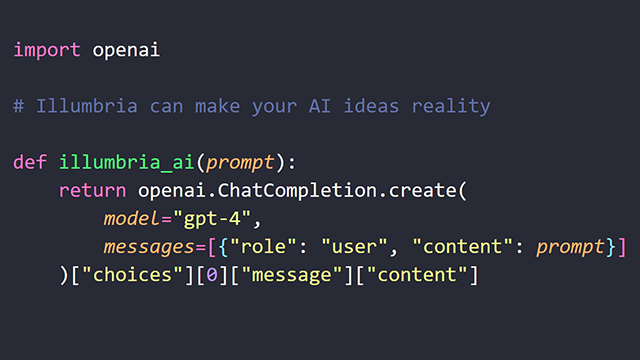Behind the Scenes: Building Custom AI Solutions
At Illumbria, we've developed a systematic approach to building custom AI solutions that deliver tangible business value. Our process combines technical expertise with deep business understanding to create AI systems that are both technologically advanced and practically effective.
In this article, we pull back the curtain on how we develop customized AI solutions, from initial concept to production deployment.
The Challenge of Custom AI Development
Off-the-shelf AI products can provide value for standard use cases, but they rarely address the specific, nuanced challenges that organizations face. Custom AI development requires a delicate balance:
The AI Development Balancing Act
Building effective custom AI solutions requires balancing technical sophistication with practical business needs, theoretical capabilities with real-world constraints, and immediate wins with long-term value.
This balancing act is why many AI initiatives fail to deliver expected outcomes. Our process is designed specifically to navigate these challenges.
Our 6-Phase Development Process
Phase 1: Discovery and Problem Definition
The foundation of every successful AI project is a crystal-clear understanding of the business problem we're solving.
Key Activities:
- In-depth stakeholder interviews across departments
- Process observation and documentation
- Data inventory and quality assessment
- Current state mapping and pain point identification
- Success metric definition and baseline measurement
This phase typically lasts 2-3 weeks and culminates in a Problem Definition Document that guides the rest of the project.
Phase 2: Solution Architecture
Once we understand the problem, we design a solution architecture that leverages the right AI capabilities for the specific challenge.
Key Activities:
- Capability matching (determining which AI approaches fit the problem)
- Data flow mapping
- Integration architecture design
- Security and compliance planning
- Prototype experimentation
The outcome is a detailed Solution Blueprint that outlines:
- Technical components and their interactions
- Data requirements and flows
- Integration touchpoints with existing systems
- Expected performance characteristics
- Implementation roadmap
Phase 3: Data Preparation
AI solutions are only as good as the data they're built upon. This phase ensures we have high-quality, relevant data to work with.
Key Activities:
- Data cleaning and normalization
- Feature engineering
- Synthetic data generation (when needed)
- Data pipeline construction
- Annotation and labeling
Our data scientists work closely with domain experts to ensure that the prepared data accurately represents the problem space and contains the signals needed for effective model training.
Phase 4: Model Development and Training
This is where the AI solution takes shape. We select, customize, and train models to address the specific business challenge.
LLM Customization Approaches
For LLM-based solutions, we employ several customization techniques depending on the use case:
| Technique | Use Case | Typical Timeline |
|---|---|---|
| Prompt Engineering | Task-specific guidance, output formatting | 1-2 weeks |
| Fine-tuning | Domain adaptation, specialized tasks | 3-5 weeks |
| Retrieval-Augmented Generation | Knowledge-intensive applications | 2-4 weeks |
| Custom Architecture | Novel capabilities, specialized requirements | 6-12 weeks |
Case Study: Financial Document Analysis
For a financial services client, we fine-tuned a base LLM on 50,000 financial documents, then implemented a retrieval system that could access their proprietary research database. The combined system achieved 94% accuracy in extracting relevant insights from complex financial reports—41% higher than their previous solution.
Beyond LLMs
While LLMs are powerful, they're not the right solution for every problem. Our toolkit includes:
- Computer vision systems for visual inspection and analysis
- Time-series forecasting for predictive maintenance and demand planning
- Reinforcement learning for process optimization
- Traditional machine learning for structured data analysis
We select the right technology for each specific challenge rather than forcing a trendy approach that doesn't fit.
Phase 5: Integration and Testing
The most sophisticated AI model provides no value until it's integrated into business workflows and systems.
Key Activities:
- API development and documentation
- User interface design and implementation
- Integration with existing systems
- Performance testing and optimization
- User acceptance testing
We employ a rigorous testing methodology that includes:
- Technical validation (accuracy, latency, throughput)
- Business validation (ROI, process improvement)
- User validation (usability, workflow fit)
Phase 6: Deployment and Continuous Improvement
AI solutions need to evolve as business needs change and new data becomes available.
Key Activities:
- Production deployment
- Monitoring system implementation
- Performance dashboard creation
- Regular model retraining
- Feedback collection and incorporation
All our solutions include a continuous improvement plan that ensures the system gets more valuable over time, not less.
Implementation Example: Manufacturing Process Optimization
To illustrate our process, let's look at how we developed a custom AI solution for a manufacturing client facing yield optimization challenges.
The Challenge
A precision components manufacturer was experiencing inconsistent quality in their output, with reject rates varying from 5-15% without clear root causes. This variability was costing them approximately $3.8M annually in wasted materials and production time.
Our Solution
We developed an integrated AI system that combined:
- Computer Vision: Automated visual inspection of components at multiple production stages
- Time-Series Analysis: Predictive modeling of machine performance degradation
- NLP Component: Analysis of maintenance logs and technician notes to extract insights
- Recommendation Engine: Real-time process adjustment recommendations
The Development Journey
Phase 1: Discovery
- Identified 27 potential variables affecting yield through process observation
- Documented the current quality control workflow
- Established baseline metrics and success criteria
Phase 2: Architecture
- Designed a multi-modal AI system to address various data types
- Created a real-time feedback loop architecture
- Developed integration plans for existing MES and ERP systems
Phase 3: Data Preparation
- Synchronized data from 12 separate systems
- Normalized historical production data (18 months)
- Created labeled datasets for visual defect recognition
Phase 4: Model Development
- Trained computer vision models on 50,000+ component images
- Developed predictive maintenance models on sensor data
- Fine-tuned an LLM on domain-specific maintenance documentation
Phase 5: Integration
- Built operator dashboards and notification systems
- Integrated with production planning systems
- Conducted parallel testing to validate recommendations
Phase 6: Deployment & Improvement
- Phased rollout across production lines
- Implemented A/B testing of AI recommendations
- Established weekly model performance reviews
Results
After six months in production:
- 62% reduction in quality-related rejects
- 28% improvement in machine uptime
- $2.1M in documented cost savings
- 17% increase in production throughput
Key Success Factors for Custom AI Development
Through dozens of implementations, we've identified several factors that differentiate successful AI projects:
- Business-First Approach: Starting with the business problem, not the technology
- Cross-Functional Teams: Blending technical expertise with domain knowledge
- Incremental Delivery: Providing value at each stage, not just at the end
- User-Centered Design: Creating solutions that people actually want to use
- Transparent Development: Making the "black box" understandable to stakeholders
- Realistic Expectations: Setting achievable goals backed by data
Conclusion
Building custom AI solutions requires a disciplined process that balances technical innovation with practical business implementation. While the specific technologies and techniques vary by project, the fundamental approach remains consistent: understand the problem deeply, design a solution that fits the specific context, implement it with rigorous attention to detail, and continuously improve based on real-world performance.
At Illumbria, this process has enabled us to deliver AI solutions that create lasting business value rather than short-lived technical demonstrations. The examples and approaches shared in this article represent our current methodology, which continues to evolve as AI technology advances and we gain new insights from each implementation.
If you're considering a custom AI solution for your business challenges, we'd be happy to discuss how our approach might be applied to your specific context. Contact us to start the conversation.


